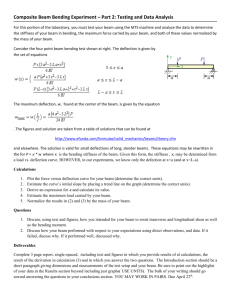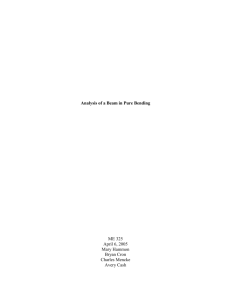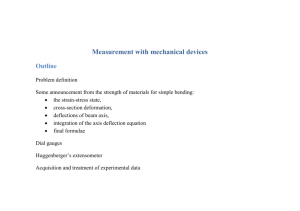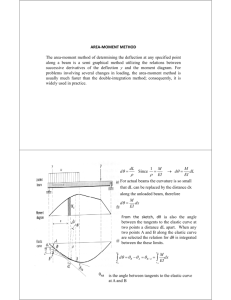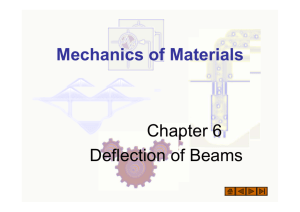Deflection of Beams and Shafts
advertisement
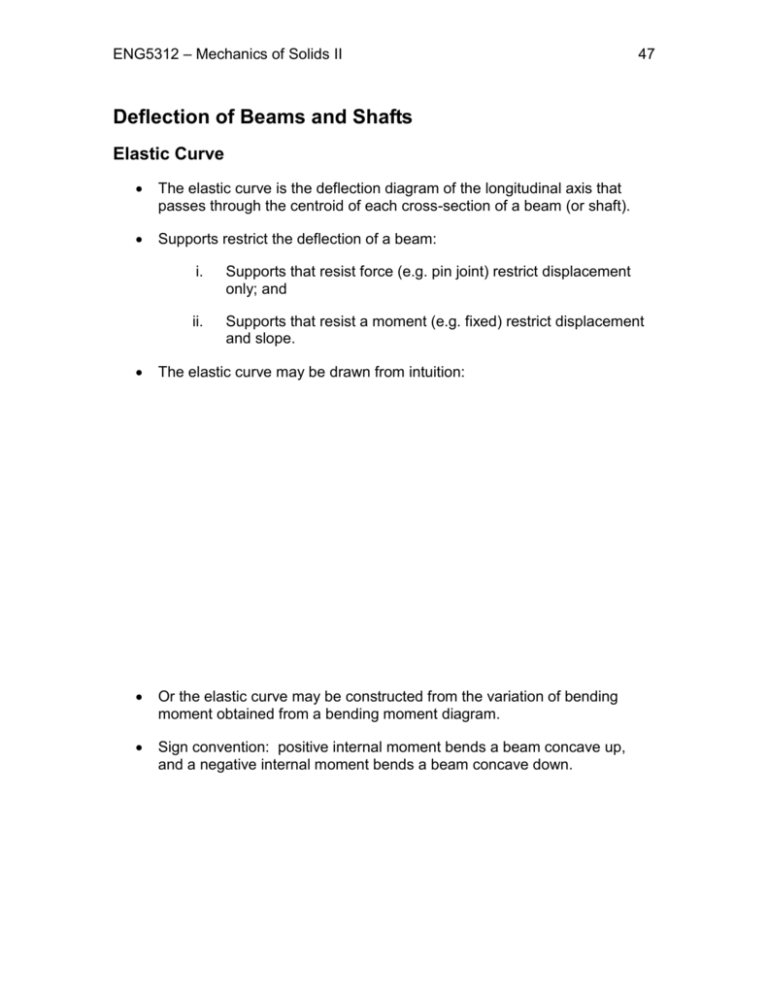
ENG5312 – Mechanics of Solids II 47 Deflection of Beams and Shafts Elastic Curve The elastic curve is the deflection diagram of the longitudinal axis that passes through the centroid of each cross-section of a beam (or shaft). Supports restrict the deflection of a beam: i. Supports that resist force (e.g. pin joint) restrict displacement only; and ii. Supports that resist a moment (e.g. fixed) restrict displacement and slope. The elastic curve may be drawn from intuition: Or the elastic curve may be constructed from the variation of bending moment obtained from a bending moment diagram. Sign convention: positive internal moment bends a beam concave up, and a negative internal moment bends a beam concave down. ENG5312 – Mechanics of Solids II When the bending moment changes sign there will be an inflection point (i.e. change from concave up to concave down, or vice versa). 48 ENG5312 – Mechanics of Solids II 49 Moment-Curvature Relationship Define the x -axis along the straight longitudinal axis of the beam and the v -axis vertically up (where v is used to measure the vertical displacement of the centroid). Define a local y -co-ordinate used to measure position up from he neutral axis. Consider the beam to be initially straight and to be deformed elastically by loadsapplied perpendicular to the x -axis, in the x,v plane. The deformation will be caused by bending moment and shear force. If the beam length is much greater than its depth, then the greatest deformation will be caused by bending. The bending moment will cause the beam to deform such that an angle d is created between the cross-sections at x and x dx . Define the radius of curvature, , as the distance from the neutral axis to the center of curvature, O' . ENG5312 – Mechanics of Solids II 50 Any arc in the element (other than the neutral axis) will experience normal strain. For the segment ds: ds'ds ds But , ds dx d (i.e. dx does not change) and ds' ( y)d . So can be written as: y d d y d Or 1 y 1 M EI (47) Or 1 Assuming the material is homogeneous and behaves in a linear-elastic manner, Hooke’s Law applies, therefore, / E and since the flexure / I : formula applies, My Ey (48) Where o is the radius of curvature at a specific location; o M is the internal bending moment; o I is the moment of inertia about the neutral axis; and o EI is the flexural rigidity (note if EI , (i.e. less curvature or bending…thus the invention of the I-beam). ENG5312 – Mechanics of Solids II 51 Note: The sign of depends on the sign of M . i. M 0 , concave up, 0, i.e center of curvature is above the beam; and ii. M 0 , concave down, 0, i.e. center of curvature below the beam. Slope and Deflection by Integration The goal is to obtain an equation for the deflection of a beam as a function of x , i.e. v f (x). From calculus: 1 d 2 v / dx 2 1 dv / dx 2 3/ 2 M EI (49) This equation is the elastica, a second-order non-linear differential equation. It will give the exact elastic curve for bending only. Unfortunately, only a few solutions are available. Usually, the desired deflections are small, therefore, the elastic curve is shallow, and the slope dv / dx must be small, so (dv / dx) 2 1 and may be neglected in Eq. (47) (for small deflections). Then: d 2v M dx 2 EI (50) Other forms of this equation may be derived using: V dM / dx and w dV / dx d d 2v EI V (x) dx dx 2 (51) d 2 d 2v EI w(x) dx 2 dx 2 (52) ENG5312 – Mechanics of Solids II 52 If the flexural rigidity is constant (realistic for many beams): EI d 4v w(x) dx 4 d 3v EI 3 V (x) dx EI d 2v M (x) dx 2 (53) (54) (55) Either of these equations may be integrated to obtain v(x) . Usually, Eq. (55) is used, i.e. determine M (x) , integrate twice, and determine the two constants of integration. Sign convention: Positive sign convention isshown in the two figures from Hibbeler below. Remember, v is measured positive up, and since small deflections have been assumed, tan dv / dx . ENG5312 – Mechanics of Solids II 53 Note: In general, the loading on a beam is discontinuous, and several functions must be written for the internal moment, with each function being valid in specific locations. Also, each function for the moment may use a different co-ordinate axis. So…several functions may be required to specify the deflection of a beam, with each function being valid in specific regions of the beam. At the intersection of two functions, continuity must be maintained (i.e. v and dv / dx ). Boundary Conditions: o Typical conditions used to evaluate the constants of boundary integration are shown in Table 12-1 of Hibbeler: Continuity Conditions: o Used to guarantee a continuous elastic curve when more than one x -co-ordinate is required to specify the bending moment ( and therefore, the elastic curve) for the beam. Both the slope and displacement must be matched.


